Structures of the multi-domain oxygen sensor DosP: remote control of a c-di-GMP phosphodiesterase by a regulatory PAS domain
- PMID: 39511182
- PMCID: PMC11543664
- DOI: 10.1038/s41467-024-53942-7
Structures of the multi-domain oxygen sensor DosP: remote control of a c-di-GMP phosphodiesterase by a regulatory PAS domain
Abstract
The heme-based direct oxygen sensor DosP degrades c-di-GMP, a second messenger nearly unique to bacteria. In stationary phase Escherichia coli, DosP is the most abundant c-di-GMP phosphodiesterase. Ligation of O2 to a heme-binding PAS domain (hPAS) of the protein enhances the phosphodiesterase through an allosteric mechanism that has remained elusive. We determine six structures of full-length DosP in its aerobic or anaerobic conformations, with or without c-di-GMP. DosP is an elongated dimer with the regulatory heme containing domain and phosphodiesterase separated by nearly 180 Å. In the absence of substrate, regardless of the heme status, DosP presents an equilibrium of two distinct conformations. Binding of substrate induces DosP to adopt a single, ON-state or OFF-state conformation depending on its heme status. Structural and biochemical studies of this multi-domain sensor and its mutants provide insights into signal regulation of second-messenger levels.
© 2024. The Author(s).
Conflict of interest statement
The authors declare no competing interests.
Figures
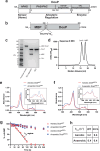
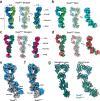
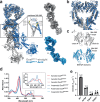

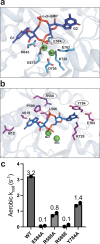
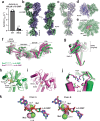
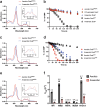

Update of
-
Structures of the multi-domain oxygen sensor DosP: remote control of a c-di-GMP phosphodiesterase by a regulatory PAS domain.bioRxiv [Preprint]. 2024 Jul 24:2024.07.24.604967. doi: 10.1101/2024.07.24.604967. bioRxiv. 2024. Update in: Nat Commun. 2024 Nov 7;15(1):9653. doi: 10.1038/s41467-024-53942-7. PMID: 39091779 Free PMC article. Updated. Preprint.
Similar articles
-
Structures of the multi-domain oxygen sensor DosP: remote control of a c-di-GMP phosphodiesterase by a regulatory PAS domain.bioRxiv [Preprint]. 2024 Jul 24:2024.07.24.604967. doi: 10.1101/2024.07.24.604967. bioRxiv. 2024. Update in: Nat Commun. 2024 Nov 7;15(1):9653. doi: 10.1038/s41467-024-53942-7. PMID: 39091779 Free PMC article. Updated. Preprint.
-
Structures of the catalytic EAL domain of the Escherichia coli direct oxygen sensor.Acta Crystallogr D Biol Crystallogr. 2013 Jun;69(Pt 6):1045-53. doi: 10.1107/S0907444913004423. Epub 2013 May 14. Acta Crystallogr D Biol Crystallogr. 2013. PMID: 23695249
-
Escherichia coli DosC and DosP: a role of c-di-GMP in compartmentalized sensing by degradosomes.Adv Microb Physiol. 2019;75:53-67. doi: 10.1016/bs.ampbs.2019.05.002. Epub 2019 Jul 12. Adv Microb Physiol. 2019. PMID: 31655742 Review.
-
An oxygen-sensing diguanylate cyclase and phosphodiesterase couple for c-di-GMP control.Biochemistry. 2009 Oct 20;48(41):9764-74. doi: 10.1021/bi901409g. Biochemistry. 2009. PMID: 19764732
-
The Heme-Based Oxygen-Sensor Phosphodiesterase Ec DOS (DosP): Structure-Function Relationships.Biosensors (Basel). 2013 Jun 17;3(2):211-37. doi: 10.3390/bios3020211. Biosensors (Basel). 2013. PMID: 25586128 Free PMC article. Review.
References
-
- Tuckerman, J. R. et al. An Oxygen-Sensing Diguanylate Cyclase and Phosphodiesterase Couple for c-di-GMP Control. Biochemistry48, 9764–9774 (2009). - PubMed
-
- Tanaka, A., Takahashi, H. & Shimizu, T. Critical Role of the Heme Axial Ligand, Met95, in Locking Catalysis of the Phosphodiesterase from Escherichia coli (Ec DOS) toward Cyclic diGMP*. J. Biol. Chem.282, 21301–21307 (2007). - PubMed
-
- Delgado-Nixon, V. M., Gonzalez, G. & Gilles-Gonzalez, M.-A. Dos, a Heme-Binding PAS Protein from Escherichia coli, Is a Direct Oxygen Sensor. Biochemistry39, 2685–2691 (2000). - PubMed
MeSH terms
Substances
Grants and funding
- R01 GM155152/GM/NIGMS NIH HHS/United States
- R00GM141261/U.S. Department of Health & Human Services | NIH | National Institute of General Medical Sciences (NIGMS)
- U24GM129547/U.S. Department of Health & Human Services | NIH | National Institute of General Medical Sciences (NIGMS)
- U24 GM129547/GM/NIGMS NIH HHS/United States
- R01GM155152/U.S. Department of Health & Human Services | NIH | National Institute of General Medical Sciences (NIGMS)
LinkOut - more resources
Full Text Sources
Miscellaneous

